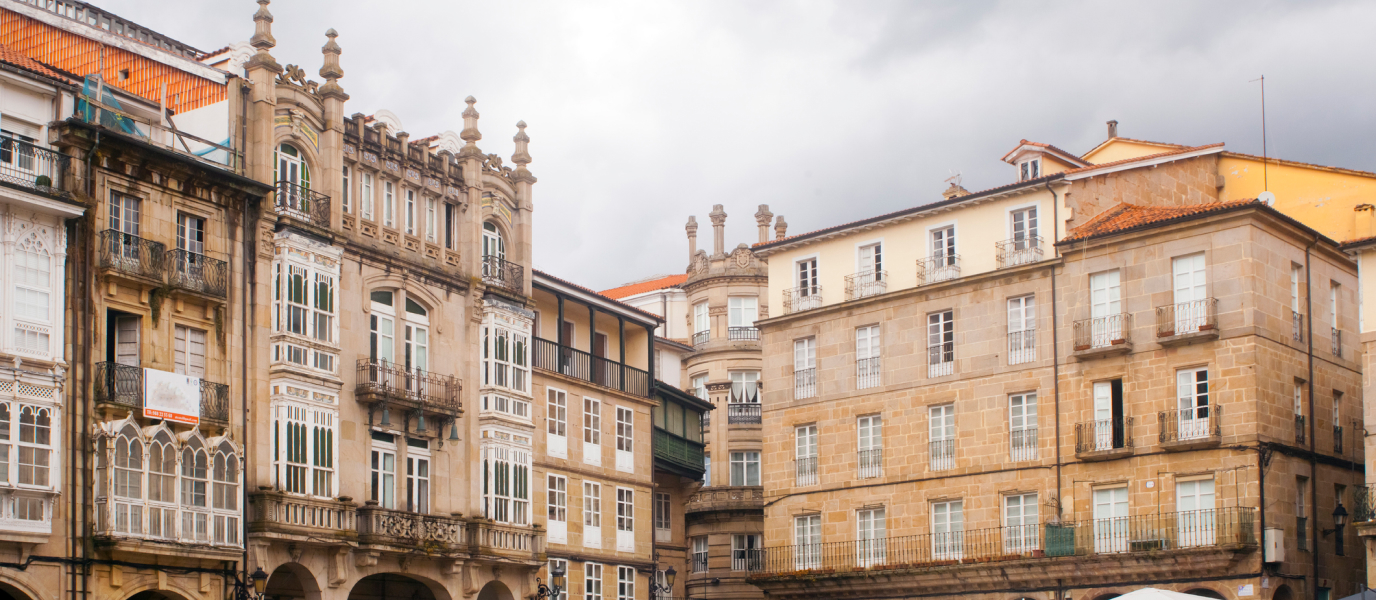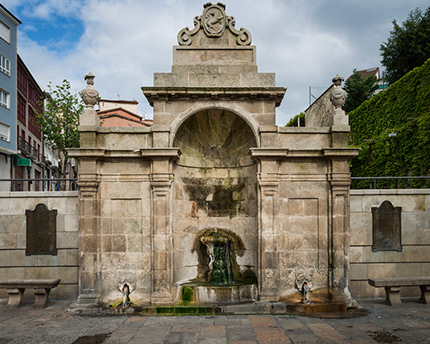The Ribeira Sacra is undoubtedly one of the best known and most visited areas in inland Galicia. There are plenty of reasons to go there, starting with oenology: some of the best and most famous wines of the region are produced there. Nevertheless, there are also historical, artistic, natural and gastronomic reasons for visiting the area.
The name Ribeira Sacra (Sacred Shore) comes from the fact that, indeed, it is a land bordering several rivers: Sil, Miño and Cabe… The waters of those rivers have irrigated the area with wealth since time immemorial. That is why the largest concentration of medieval religious settlements (mainly Romanesque) in Galicia are found there. Hence the name Sacra (sacred).
Travelling through those river valleys, between breathtaking terraces planted with vineyards where heroic viticulture has been practised since ancient times, is something that leaves no one indifferent. Just as impressive is sailing along the Sil Canyon aboard one of the tourist boats that dock at its jetties. You can also taste a wine from the Ribeira Sacra Designation of Origin wineries, while contemplating the landscape from one of the impressive viewpoints overlooking the river.
Here are some of the best places to see in the Ribeira Sacra and good ideas to make the most of your visit.
Saint Steven’s Monastery
This religious centre is one of the must-see places in the Ribeira Sacra. Saint Steven’s Monastery is a real gem in Galicia’s historical heritage, partly converted into a hotel (Santo Estevo Parador). A place amidst dense forests that continues to surprise us with its size and the mastery with which the stones of its façades, church and cloisters were carved.
It dates back to the 6th century, when the man who later became known as Saint Martin of Braga set up a hermitage there. Nevertheless, what can be seen today is the construction erected between the 12th and 18th centuries by different monastic orders.
Long before that, this religious centre must have been of great importance in the area since it is known that nine bishops retired there before their death and their mitres are depicted on its coat of arms.
The church has a basilica floor plan and houses an artistic Renaissance altarpiece signed by Juan de Angés (16th century) and another altarpiece, difficult to date, made of stone and representing Christ in Majesty with the 12 apostles. Also notable are the porter’s cloister and the bishops’ cloister, where those nine bishops are buried, who are also the protagonists of a legend surrounding their supposedly miraculous rings.
Sil Canyon
The abrupt geology of the river Sil in this area has generated a natural canyon over millions of years. It is one of the most unique landscapes in Galicia and clearly one of the reasons why you should visit the Ribeira Sacra. The two banks of the river, each one in a different Galician province (Ourense and Lugo), acquire the character of a gorge, or canyon, in the final stretch of the river, before its confluence with the river Miño.
In total, there are some 35 kilometres of gradients of between 200 and 500 metres in altitude (or even more), with many terraced sections from ancient times where vines have been cultivated. This is what is known as heroic viticulture (due to the obvious difficulty of the work in such circumstances), which has been the livelihood of many families in the Ribeira Sacra over the centuries.
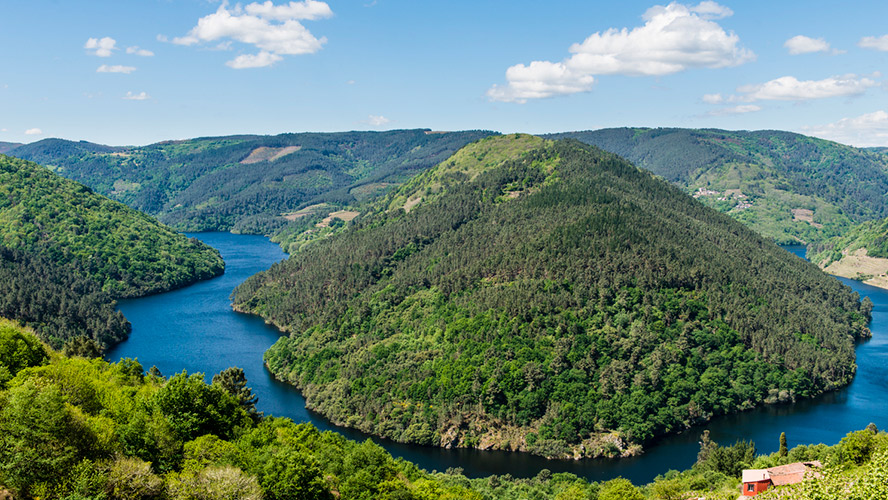
Human action aside, this is also an area of great natural value since the river’s humidity has created an ideal habitat for numerous plant and animal species. In terms of plant species, oak, chestnut, cork oak and strawberry tree forests abound. In terms of animals, there are large birds of prey such as the golden eagle, eagle owl, peregrine falcon and blue rock thrush.
The best way to visit and get to know this stunning and seductive habitat is with the boat trips that cross the river from the jetties of Abeleda, Ponte do Sil, Os Chancís and Santo Estevo, with routes lasting between one and two hours.
Saint Christina’s Monastery
Among all the places to see in the Ribeira Sacra, Saint Christina’s Monastery was one of the most important religious centres thanks to the fame and wealth it achieved during the Middle Ages.
Located in a superb spot in the municipality of Ribas de Sil, i.e. the Merilán Grove, it dates back to the 10th century. Its Romanesque church (12th-13th centuries) remains from the medieval period, with its three semicircular apses standing out. The central one is decorated with several mural paintings (16th century) depicting Saint John and the Virgin, Saint Thomas, Saint Dominic and Saint Anthony, as well as Saint Lucy and Saint Barbara.
From the Renaissance period is the part of the monastery where the monks lived, as well as two wings of the cloister, although they are rather tarnished since it is evident that in that period this religious centre had lost part of its power (in favour of Saint Steven’s Monastery).
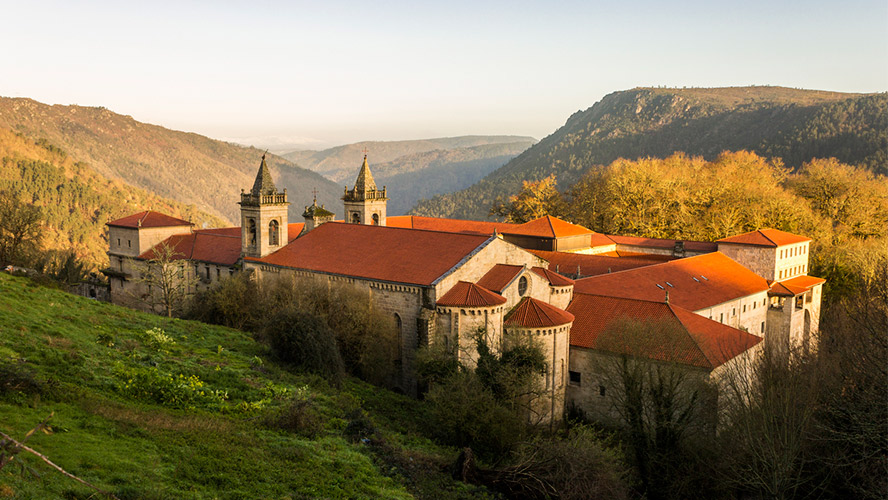
River Mao walkways
The river Mao is one of the tributaries of the Sil and therefore forms part of the water system that irrigates the Ribeira Sacra. As it passes through the area and up to its mouth, it also leaves a narrow, stony canyon covered with riverside woods.
A good part of this small gorge (about 1.8 kilometres) is crossed by comfortable wooden walkways, which form a return route along which you can explore much of the area’s natural wealth.
The path marked by those walkways partly coincides with the PR-G 177 route and starts at the Fábrica de Luz, an old hydroelectric power station that is now a hostel. It can be reached from the small village of Cristosende by the OU-0605 road, which runs parallel to the river Mao itself and then to the Sil Canyon.
Vilouxe viewpoint
Of all the viewpoints along the Sil Canyon, this is undoubtedly the most impressive. Firstly, because it is about 700 metres above the river’s course. Secondly, because of the superb panoramic view that can be seen from there: the Coto das Boedas meander, where it is popularly said that ‘the river turns around’.
Despite its proximity to Vilouxe, a small village where you should leave your vehicle and then climb to the viewpoint after a path of about 800 metres, it is a completely natural environment, with no human intervention. This means that you should approach the edge of the canyon with caution as there is no protection whatsoever and the vertical drop is, to say the least, hair-raising.
Once you have taken the appropriate precautions and overcome your sensation of vertigo, the only thing left to do is enjoy the breathtaking panoramic view from that viewpoint.
Balcones de Madrid viewpoint
This viewpoint in the Ribeira Sacra, also known as Os Torgás, is so called because it was the place from where the local families watched the men who emigrated to other lands (mainly Madrid and the rest of Castile) leave in search of fortune and a better life.
It is located near Parada de Sil and, like the previous viewpoint, from there you can see one of the most impressive panoramic views of the Sil Canyon, in this case protected by wooden railings.
From there you can see, apart from the river Sil and the gorge that surrounds it, the Cadeiras Sanctuary, located at an altitude of 500 metres, numerous vineyard terraces next to Porta Brosmos and Sacardebois, as well as the nature that surrounds Monforte de Lemos.
Wineries in the Ribeira Sacra
The great wealth of the Ribeira Sacra and the uniqueness of its landscapes have much to do with wine production. Hundreds of hectares of farmland, often in almost impossible growing conditions, make up one of the most unique and commendable wine appellations in the country. The around 100 wineries are mostly small, with fairly limited production and are family-run.
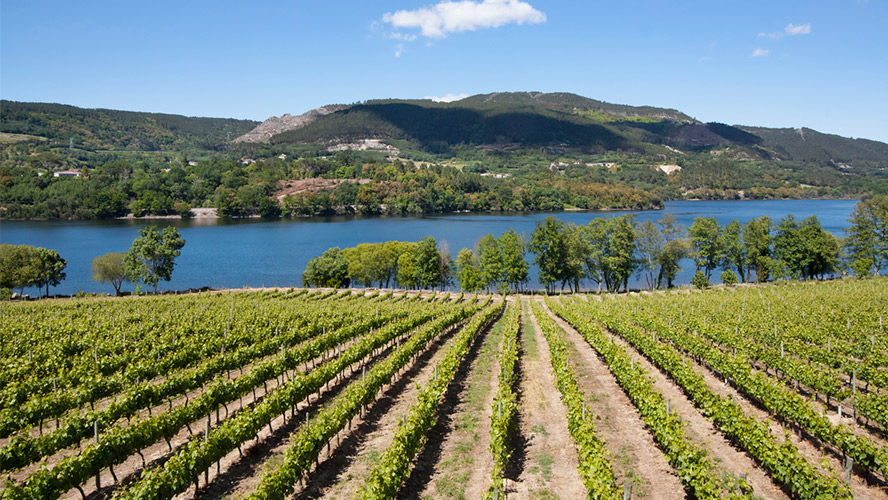
Some of them provide visits and tastings of their wines, mainly reds of the Mencía variety, but also some whites made from Godello and Albariño grapes. Among the best known are Rectoral de Amandi, Abadía da Cova-Adegas Moure (in Cuñas), Regina Viarum (Doade), Vía Romana (A Ermida-Belesar), Cruceiro (Vilachá de Doade), Lar de Ricobao (Quiroga), Vella (A Abeleda), Lareu (Chantada) and Val do Frade (Pobra do Brollón).
Given their dimensions and the small size of their business, if you want to visit any of them, the best thing to do is call and arrange a visit. This option is also usually included in the tours that tourist companies organise in the Ribeira Sacra.
Villages in the Ribeira Sacra
In total, there are 21 municipalities that make up the Ribeira Sacra area, each with several villages of varying sizes. In fact, a large part of Galicia’s rural population lives in small villages and hamlets with few inhabitants, scattered throughout the territory and administratively grouped into parishes and municipalities. This is also the case in the Ribeira Sacra: with some exceptions, there are hardly any large villages there. The most interesting ones are as follows:
– Ribas de Sil: this municipality is one of the main wine references in the Ribeira Sacra. It is divided into several small villages, the main one is San Clodio, where the town hall is located. Ribas de Sil is home to some of the main religious centres in the Ribeira Sacra: Saint Steven, Saint Christina and Saint Clodio.
– Ferreira de Pantón: this municipality has grown since the Middle Ages around the Cistercian monastery of the Holy Saviour, also known as Saint Mary of Pantón. A monastic complex laid out around a harmonious two-storey cloister, which was founded around the 10th century and then assimilated, in the 12th century, the Cistercian order, which was the one that endowed it with splendour and the beautiful architecture that characterises it.
– Ribas de Miño: this village, which belongs to the municipality of O Saviñao (Lugo), is home to some interesting monuments such as the parish church (Saint Steven), built in the 12th century in Romanesque style, whose façade was undoubtedly inspired by the Portico of Glory of the cathedral in Santiago de Compostela. Also in the municipality are the Guadalupe Sanctuary (18th century), in the middle of a beautiful natural setting, and an archaeological site with barrows (megalithic structures).
– Monforte de Lemos: this is the main town in the Ribeira Sacra, capital of the region of Terra de Lemos and an important railway link between Galicia and Castile since the time of Alfonso XIII. The town grew around the Monastery of Saint Vincent of Pino, whose origins date back to the 10th century, although the current image corresponds to the total reform undertaken in the 16th century in Renaissance style. The Colegio de Nuestra Señora de la Antigua school, known as the Galician Escorial, also dates from that period.
– Os Peares: if there is a symbolic place in the Ribiera Sacra, this is it because in Os Peares the rivers Sil and Miño and the provinces of Ourense and Lugo converge. The village’s greatest splendour came in the 20th century thanks to the railway and the reservoir. Among the most interesting constructions is the railway bridge, built in iron under the Eiffel style. There is also a pleasant river beach.
– Castro Caldelas: it is a delight to stroll through the historic centre of this town, in particular the Cima de Vila, with its cobbled streets below the castle, built by the seventh Count of Lemos (Pedro Fernández de Castro) in the 14th century. It is one of the best-preserved medieval urban ensembles in Galicia.
Routes in the Ribeira Sacra
The most effective way to get to know the Ribeira Sacra and reach the most hidden places is clearly on board a vehicle (car or motorbike). However, due to its many natural values and the difficult access to some of its villages, touring this area on foot or by bicycle is also a good option. Here are some of the most recommended hiking routes:
– Belesar vineyard route: on the banks of the river Miño, this route is about 5 kilometres long, which can be covered in about two hours. Apart from the vineyards, the path winds its way through chestnut and oak woods.
– San Pedro de Rocas Royal Road: the route runs for about 9 kilometres along what was in fact the royal road that reached the city of Ourense (corresponding link). At the end of the route is the Monastery of Saint Peter the Rock in Esgos, considered as the first settlement of hermits in Galicia since its origins go back to the 6th century.
– Watermills in Castro Caldelas: a large part of the route runs parallel to the river Edo, through thick riverside vegetation. In total, you walk a little over 2.5 kilometres for about three quarters of an hour of pleasant walking. There you will see the remains of three old watermills (‘muiños’).
– Chestnut and Honey Route: this is a circular route of about 9 kilometres that starts in Salcedo and partly coincides with the ‘ruta do ouro e do ferro’ (gold and iron route). Along the way you can see several ‘albarizas’ (round stone constructions that protect beehives), as well as a chestnut drying place in Souto de Paramedela.
How to get to the Ribeira Sacra
Due to its extension and linearity, the Ribeira Sacra can be reached from different parts of Galicia and the rest of Spain. From the city of Ourense, it is easily accessible by the Barra de Miño road and also by the N-120 in a journey of about 20 minutes in your own vehicle.
From Lugo you can reach Monforte de Lemos and, from there, the main villages in the Ribeira Sacra, on the LU-546 road, in just under an hour’s drive by car or motorbike. The N-120 which, for many kilometres, runs parallel to the course of the river Sil, allows easy access from the province of León (Bierzo area) to the heart of the Ribeira Sacra.
By train (Renfe) you can reach San Esteban del Sil and Monforte de Lemos from Madrid and the rest of Spain.
On the other hand, there are no bus lines that allow you to reach most of the towns in the Ribeira Sacra in a comfortable way. Even so, if you want to get to know the area by public transport, there are several boat companies that run mini-cruises along the Sil Canyon, as well as the Aba Sacra tourist mini-train, which follows part of the Sil gorge by road and in parallel.
Where to stay in the Ribeira Sacra
One of the best hotel options in the province is the Barceló Ourense, located in the city of Ourense and, therefore, about 20 minutes by road from the first villages of the Ribeira Sacra. Focused on business travellers due to its central location, it is also ideal for people visiting Ourense for holidays. All its rooms (44 doubles) have been decorated and equipped with the modern and functional B-Room concept and are the most spacious in the city. The hotel also offers its guests a fitness area with sauna and the possibility of having a snack or drink in the lobby bar, with a large menu selection.






























































